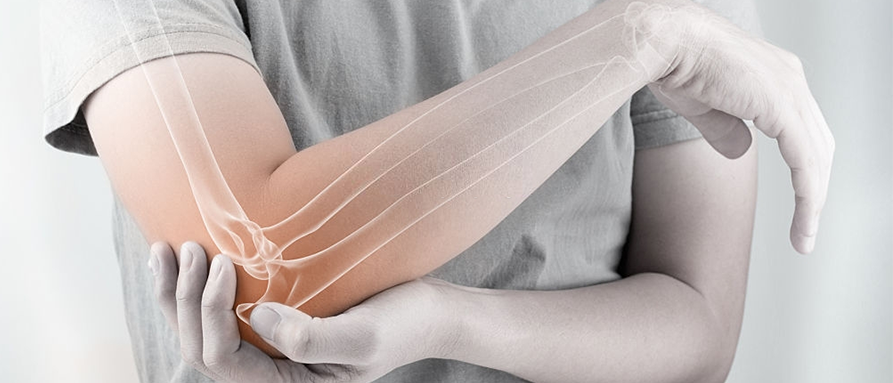Book An Appointment
Rheumatoid Arthritis
Side Bar

Rheumatoid Arthritis
Rheumatoid arthritis is a chronic autoimmune inflammatory disorder that can affect multiple joints of the body starting from small joints of hands and feet. In some people, the condition can damage a wide variety of body systems, including the skin, eyes, lungs, heart and blood vessels.
An autoimmune disorder, rheumatoid arthritis occurs when your immune system mistakenly attacks your own body's tissues.
Signs and symptoms of rheumatoid arthritis may include:
- Tender, warm, swollen joints
- Joint stiffness that is usually worse in the mornings and after inactivity (morning stiffness)
- Fatigue, fever and loss of appetite
Early rheumatoid arthritis tends to affect your smaller joints first — particularly the joints that attach your fingers to your hands and your toes to your feet.
As the disease progresses, symptoms often spread to the wrists, knees, ankles, elbows, hips and shoulders. In most cases, symptoms occur in the same joints on both sides of your body (symmetrical involvement of joints).
About 40 percent of the people who have rheumatoid arthritis also experience signs and symptoms that don't involve the joints. Rheumatoid arthritis can affect many nonjoint structures, including:
- Skin
- Eyes
- Lungs
- Heart
- Kidneys
- Salivary glands
- Nerve tissue
- Bone marrow
- Blood vessels
Rheumatoid arthritis signs and symptoms may vary in severity and may even come and go. Periods of increased disease activity, called flares, alternate with periods of relative remission — when the swelling and pain fade or disappear. Over time, rheumatoid arthritis can cause joints to deform and shift out of place. In neglected cases, patients present with deformed, stiff joints become relatively painless.
Risk factors
The exact cause or inciting agent (genetic, environmental) are not known and still a topic for research.
Factors that may increase your risk of rheumatoid arthritis include:
- Your sex. Women are more likely than men to develop rheumatoid arthritis.
- Age. Rheumatoid arthritis can occur at any age, but it most commonly begins in middle age.
- Family history. If a member of your family has rheumatoid arthritis, you may have an increased risk of the disease.
- Smoking. Cigarette smoking increases your risk of developing rheumatoid arthritis, particularly if you have a genetic predisposition for developing the disease. Smoking also appears to be associated with greater disease severity.
- Environmental exposures. Although poorly understood, some exposures such as asbestos or silica may increase the risk of developing rheumatoid arthritis. Emergency workers exposed to dust from the collapse of the World Trade Center are at higher risk of autoimmune diseases such as rheumatoid arthritis.
- Obesity. People — especially women age 55 and younger — who are overweight or obese appear to be at a somewhat higher risk of developing rheumatoid arthritis.
Diagnosis
During the physical exam, we will check your joints for swelling, redness and warmth.
Blood tests
People with rheumatoid arthritis often have an elevated erythrocyte sedimentation rate (ESR, or sed rate) or C-reactive protein (CRP), which may indicate the presence of an inflammatory process in the body. They are also important to monitor the disease activity and follow the progress of the disease to adjust the medicines. Other common blood tests look for rheumatoid factor (RA factor) and anti-cyclic citrullinated peptide (anti-CCP) antibodies.
Imaging tests
We may recommend X-rays to help track the progression of rheumatoid arthritis in your joints over time. MRI and ultrasound tests can help us judge the severity of the disease in your body.
Treatment
=> Medications
The types of medications recommended by us will depend on the severity of your symptoms and how long you've had rheumatoid arthritis.
- NSAIDs. Nonsteroidal anti-inflammatory drugs (NSAIDs) like diclofenac, ibuprofen can relieve pain and reduce inflammation. Side effects may include stomach irritation, heart problems and kidney damage.
- Steroids. Corticosteroid medications, such as prednisone, reduce inflammation and pain and slow joint damage. Side effects may include thinning of bones, weight gain and diabetes. Doctors often prescribe a corticosteroid to relieve acute symptoms, with the goal of gradually tapering off the medication.
- Disease-modifying antirheumatic drugs (DMARDs). These drugs can slow the progression of rheumatoid arthritis and save the joints and other tissues from permanent damage. Common DMARDs include methotrexate, leflunomide, hydroxychloroquine and sulfasalazine.
Side effects vary but may include liver damage, bone marrow suppression and severe lung infections.
- Biologic agents. Also known as biologic response modifiers, this newer class of DMARDs includes rituximab and adalimumab have been recently introduced in Indian market with promising results, though are costly.
These drugs can target parts of the immune system that trigger inflammation that causes joint and tissue damage. These types of drugs also increase the risk of infections. Biologic DMARDs are usually most effective when paired with a nonbiologic DMARD, such as methotrexate.
=> Surgery
If medications fail to prevent or slow joint damage, you and your doctor may consider surgery to repair damaged joints. Surgery may help restore your ability to use your joint. It can also reduce pain and improve function.
Rheumatoid arthritis surgery may involve one or more of the following procedures:
- Synovectomy. Surgery to remove the inflamed lining of the joint (synovium) can be performed on knees, elbows, wrists, fingers and hips.
- Tendon repair. Inflammation and joint damage may cause tendons around your joint to loosen or rupture. Your surgeon may be able to repair the tendons around your joint.
- Joint fusion. Surgically fusing a joint may be recommended to stabilize or realign a joint and for pain relief when a joint replacement isn't an option.
- Total joint replacement. During joint replacement surgery, we remove the damaged parts of your joint and inserts a prosthesis made of metal and plastic.
At team treats thousands of patients each year with Rheumatoid arthritis and sacroilitis successfully on OPD basis with few needing admission for surgical procedures.